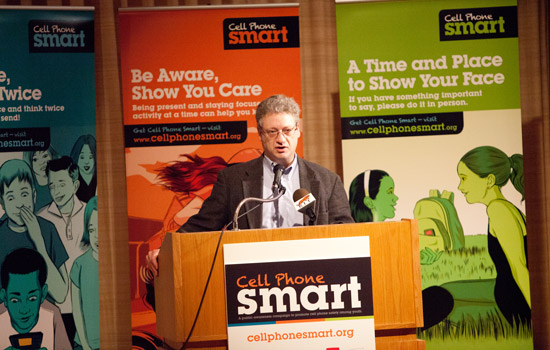RIT partners to promote youth cell-phone safety
Cell Phone Smart campaign targets 8- to 11-year-olds
Timothy Toal ’90
Sam McQuade, director of graduate studies in RIT’s Center for Multidisciplinary Studies, discusses Cell Phone Smart, a public-awareness campaign promoting cell-phone safety among youth that was announced Tuesday at The Strong’s National Museum of Play. RIT is a partner in the effort with Project Youth Safety and other organizations.
Because today’s youth have access to cell phones at an earlier age than ever before, it’s critical to provide them with information to help them use cell phones safely and responsibly.
That was one of the key messages shared on Tuesday when a public-awareness campaign promoting cell-phone safety for children was announced at The Strong’s National Museum of Play.
Project Youth Safety is teaming with RIT and other partners on the campaign, called Cell Phone Smart. Unique to Rochester, the effort aims to share three messages:
Be Nice, Think Twice—Cell phones aren’t like locked diaries or the secret box you keep stuffed under your bed. The text you send your best friend might be forwarded to someone else. And if a friend sends a text meant for your eyes only, be a good pal and keep it to yourself. Be safe, be nice and think twice before you hit send.
Be Aware, Show You Care—Riding your bike and talking on your phone at the same time isn’t smart. Neither is playing games at the dinner table. While it may be tempting, don’t spend your time surfing the Web at a family gathering. Being present and staying focused on one activity at a time can help keep you safe.
A Time and Place to Show Your Face—There are times when using a cell phone is great. But often, it’s more meaningful to talk face-to-face. So if you have something important to say, do it in person.
The messages, targeting kids 8 to 11 years old, along with parents, teachers and community leaders, will be shared in radio public-service announcements, movie theater advertisements, online banner ads, posters and brochures.
“INOBTR is proud to lead this campaign, teaching young people in Rochester that owning a cell phone is a privilege, and with that privilege comes responsibility and accountability,” says Kelly McMahon, communications director for INOBTR, (which stands for “I Know Better”), a nonprofit organization focused on keeping kids safe through education. “Our goal is to educate kids at the ground level about when, where and how it’s appropriate to use a cell phone.”
Rochester was selected for the pilot program in large part due to research into cybercrime among youth by Sam McQuade, director of graduate studies in RIT’s Center for Multidisciplinary Studies, and RIT’s prior collaborations on youth cybersafety curriculum and workshops with local school districts.
“It’s about kids of all ages, but it’s also about schools and parents and adult role models and the business community, because as society becomes more and more high tech, more people are using more devices for more things in more ways,” McQuade said at Tuesday’s announcement. “The more time that kids and others spend online, the more likely it is that they will experience harm or abuse in some way or become involved in that even unwittingly.
“This was a major effort to change society’s thinking about what was happening online, and to do it in a positive way that told a message of hope and safety and security and acting responsibly, because that’s in the interests of the individual and communities and societies as a whole. We figured out what needed to be taught and a way to teach it. It’s an intergenerational issue, and everyone in society deserves to be safe when they’re online.”
The campaign is supported by the U.S. Department of Justice’s Office of Juvenile Justice and Delinquency Prevention; Project Youth Safety, a multimedia, multicultural public-awareness initiative promoting child and youth safety at the community level; INOBTR; and the Internet Keep Safe Coalition (also known as iKeepSafe), an international alliance that teaches youth about using new-media devices in safe and healthy ways.














